Tubedragons
Aquatic Tubedragons
Amphibious Tubedragons
"salamander-like tubedragon"
Rough Tubedragons
"lizard-like tubedragon"
Flumps
Noodlenecks
Wooly Tubedragons
Grubhunters
Wallcrawlers
Flowerworms
Lesser Threadtongues
Greater Threadtongues
Fantongues
Longbodied Wall-Lickers
Musclesuckers
Velvetleeches
Aquatic Tubedragons
Amphibious Tubedragons
Rough Tubedragons - Aspertubi
Globoformoidea
Flumps
(Ascidolethridae)
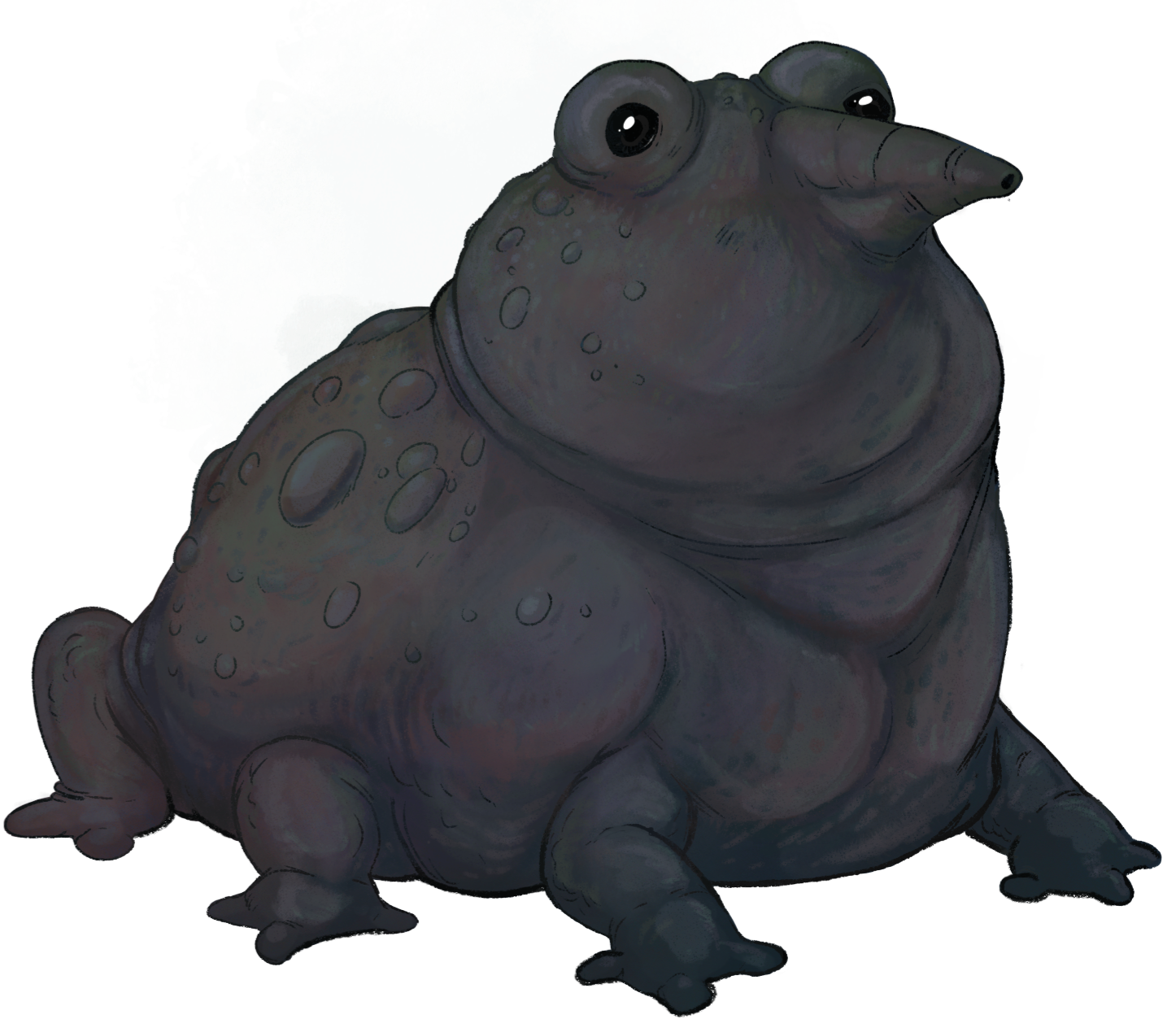
Flumps are nearly sedentary ambush predators that strike potential prey
with a harpoon-tipped, venomous 'tongue' (actually an eversible pharynx). They favor vertebrate prey, but won't pass up larger invertebrates.
Their soft, baglike bodies allow them to swallow animals slightly larger than themselves. They also tend to
sting creatures they couldn't possibly eat. While many species have venom that's painful but non-lethal,
a few pack a punch so potent it can stop a harusper’s heart in minutes. Their powerful venom allows them to
subdue prey almost immediately without being injured. Venom is also a vital defence mechanism for something
as very soft, fragile, and generally bad at walking as the flump. Many species of flumo can change the color
and pattern of their skin to better camoflage with their chosen hiding spot, making them difficult to detect
for prey, predators, and barefoot pedestrians alike.
Some say there’s a species of Flump for every district of the city, and they’re not far off. The high level
of speciation found in flumps is thought to be a result of the fact populations are easily isolated from
eachother by the terrain of the city, with no ability to climb or swim, the individuals who find themselves
in a particular area aren’t necessarily well equipped to leave it, or return if they do.
Reproduction
In the upper regions of the city, where heat from the suns is more strongly felt, flumps reproduce during the summer series. Males often take on elaborate colorations during this time and emit thin, whistling calls to attract females. In the lower regions of the city, there is no temperature-dictated mating season, and reproduction is a continuous event for the population. Males call at all times, and females seek them out when ready to breed. Copulation is a brief affair. The pair align themselves back-to-back, and the male quickly penetrates the female’s cloaca with an evertable organ that deposits a sperm packet into the female. All in all, the process takes only seconds. The eggs the female later lays have thin, leathery shells; she buries them as best as she can manage in a quiet, hidden spot. While adult flumps have few predators due to their venemous sting, this isn't true of their eggs. The young they hatch into are identical to the adults, only much smaller, and more willing to hunt insects.
Dolichocolloidea
Noodlenecks
(Ereunauchenidae)
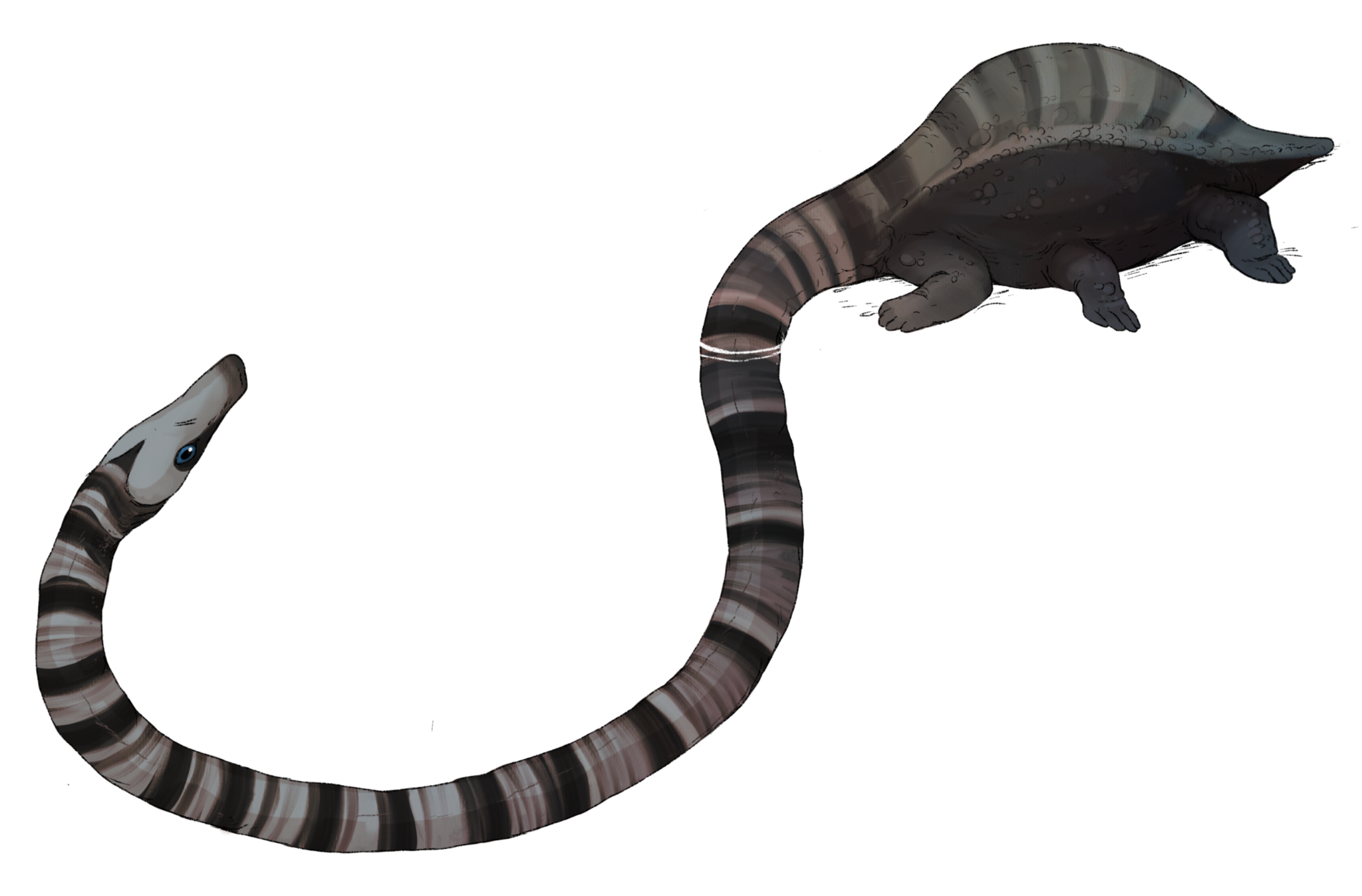
Noodlenecks are semi-aquatic predators. While their heavy bodies remain on land, they hunt in gutters, ponds, and other waterways with their flexible, elastic necks. They have a short, barbed tongue they use to inject paralytic venom into fish, which they swallow whole once stunned. Males fight for territory, usually about a hundred-foot-or-so stretch of bank, with an elaborate, ritualized combat display that involves twining their necks, and attempting to push the opponents head into the water. Since the nostrils of the noodleneck are on the back of the torso near the shoulders, this carries no risk of drowning and is simply a contest of strength. Females tend to move between these territories. Ultimately noodlenecks seem largely unconcerned with eachother, preferring to focus on fishing until it comes time to breed.
Wooly Tubedragons - Lanitubi
Xynoformoidea
Grubhunters
(Brephodaptidae)
Grubhunter tubeworms evolved to extract larvae from livehives, boreholes, and other places where soft,
immature organisms can be found. While their ancestor had a single spike or harpoon at the end of its tongue, the
tongues of grubhunters are much thornier, often lined with rows of hooks down its distal end.
It's thought their wooly coats first evolved to protect their skin from the stinging insects they invaded the nests
of, and later proliferated due to the side-effect of helping with thermoregulation.
Wallcrawlers
(Mureptilidae)
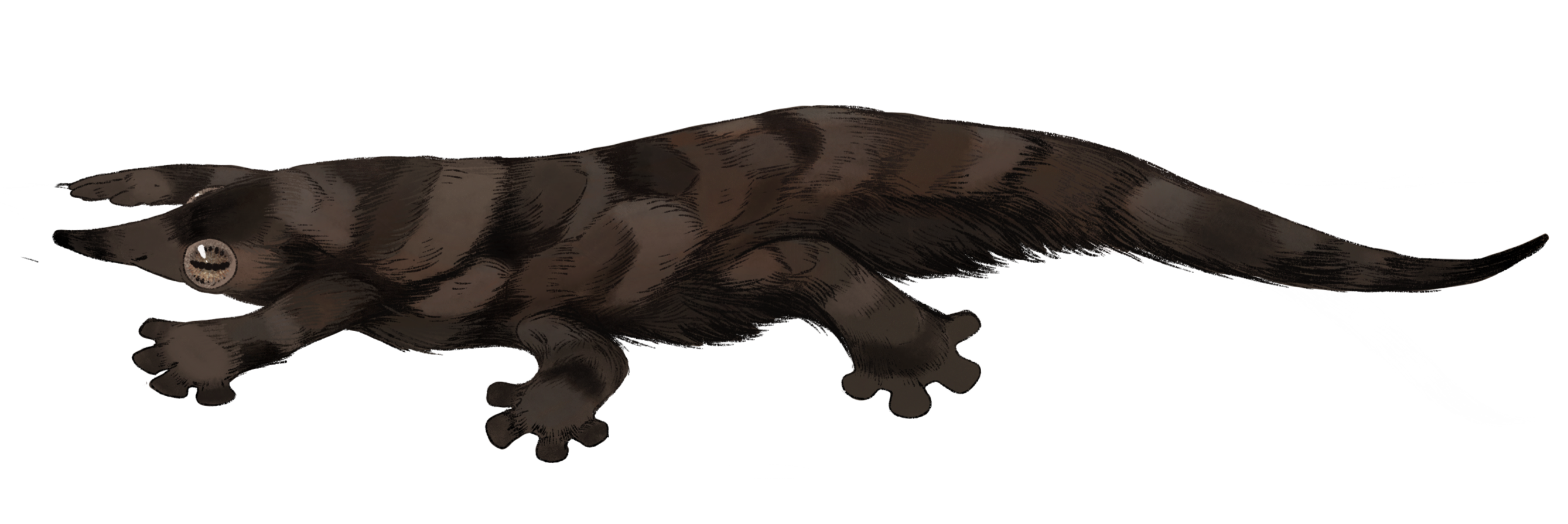
Wallcrawlers are (often extremely well camouflaged) ambush predators with feet that allow them to cling to walls
and ceilings, hence the name. The pharynx is less heavily weaponized than grubhunters, but still covered in small spines that
help grip their insect prey.
Wallcrawlers lay eggs in sticky mats, cementing them in place with mucus strong
enough to hold them to vertical walls, or even ceilings and the undersides of ledges. In some places, Haruspers and
Vuxte consider these eggs to be a delicacy due to their crisp texture and light, fruity flavor. The fact that the
wallcrawler species most known for their eggs are somewhat difficult to breed in captivity helps maintain the rarity, and
price, of the product.
Flowerworms
(Anthipodae)
Flowerworms are small, brightly colored tubedragons that feed on nectar. It’s thought they
evolved from wallcrawlers that took to hiding in flowers to ambush pollinators, but eventually began to
feed more and more on the flowers themselves. This said, small insects are still a significant portion of
their diet. They have lost all pharyngeal dentition.
The keeping of flowerworms as pets was once a fairly niche hobby only for those willing to hand-gather nectar
for them, but the development of artificial feed mixes that can be stirred into water and several clever
marketing campaigns for supplies to house them has led to the proliferation of them as decorative pets.
Often they are kept on counters, desks, and tables alongside potted plants. This boom in popularity
has led to an impressive number of color morphs, hybrids, and decorative mutations.
Flowerworms are highly territorial and will attack others of their own species, and posture aggressively
at anything perceived to be a threat. This means they can’t be kept together, but also makes them highly
entertaining to watch. However, those kept in high-traffic areas have been known to die of stress if not
provided with shelter.
Mitoglossoidea
Threadtongues are insectivorous, like the more basal grubhunters, though they specialize specifically on antlike organisms. They lack any form of pharyngeal dentition.
Lesser Threadtongues
Greater Threadtongues
(Cladophoradae)
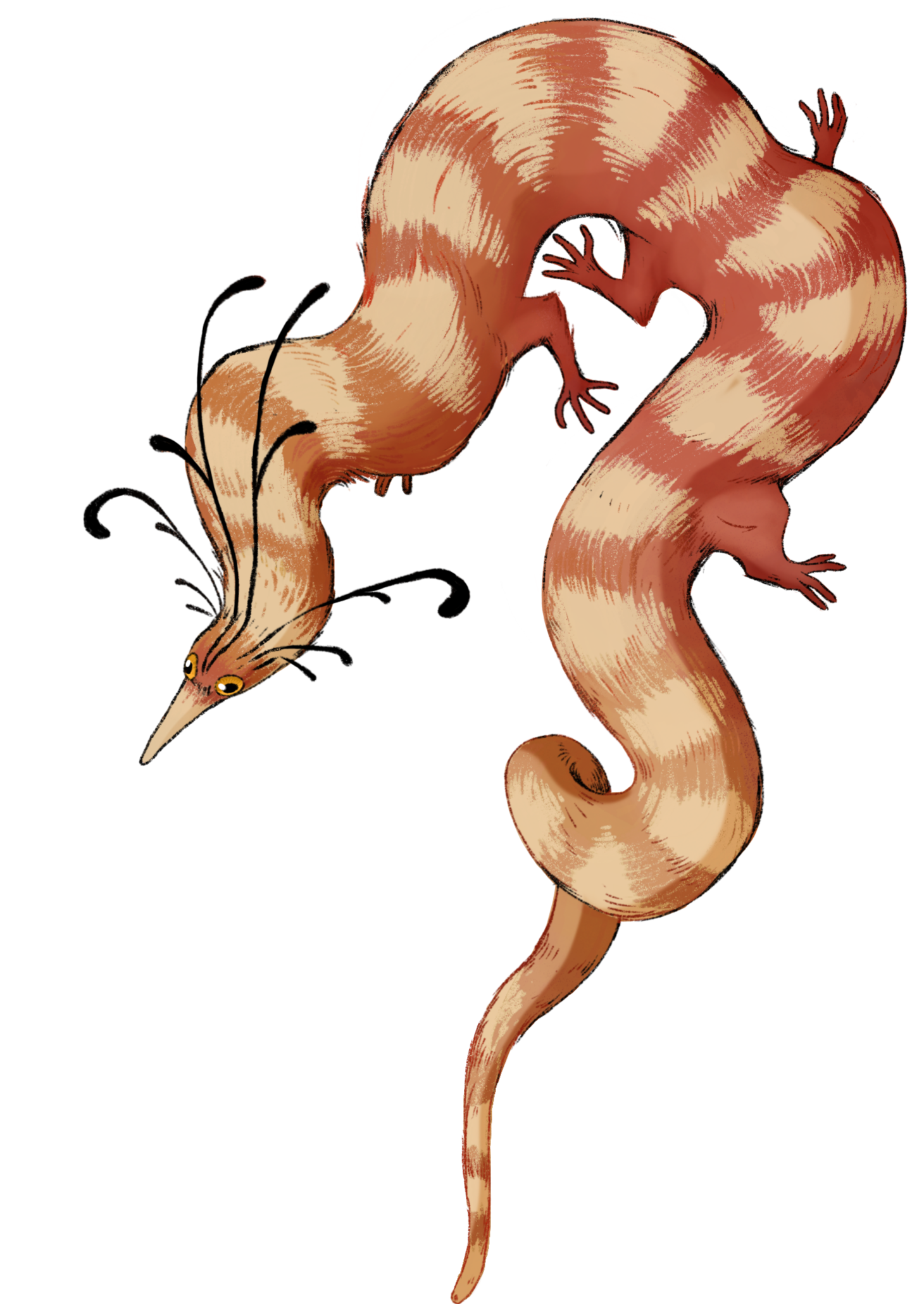
The greater threadtongues are the largest terrestrial members of the entire tubedragon order, with some species regularly reaching 10ft long at maturity. Despite their size, they’re also among the most elusive. They rarely come near heavily populated areas of the city, making their life histories difficult to study. The tendency for shyness is not unexpected amongst any beast, but was perhaps accelerated in these species by the extensive hunting campaigns by people after their pelts, which are impressively soft.
Pharynodaxoidea
Fantongues
(Patulinguadae)
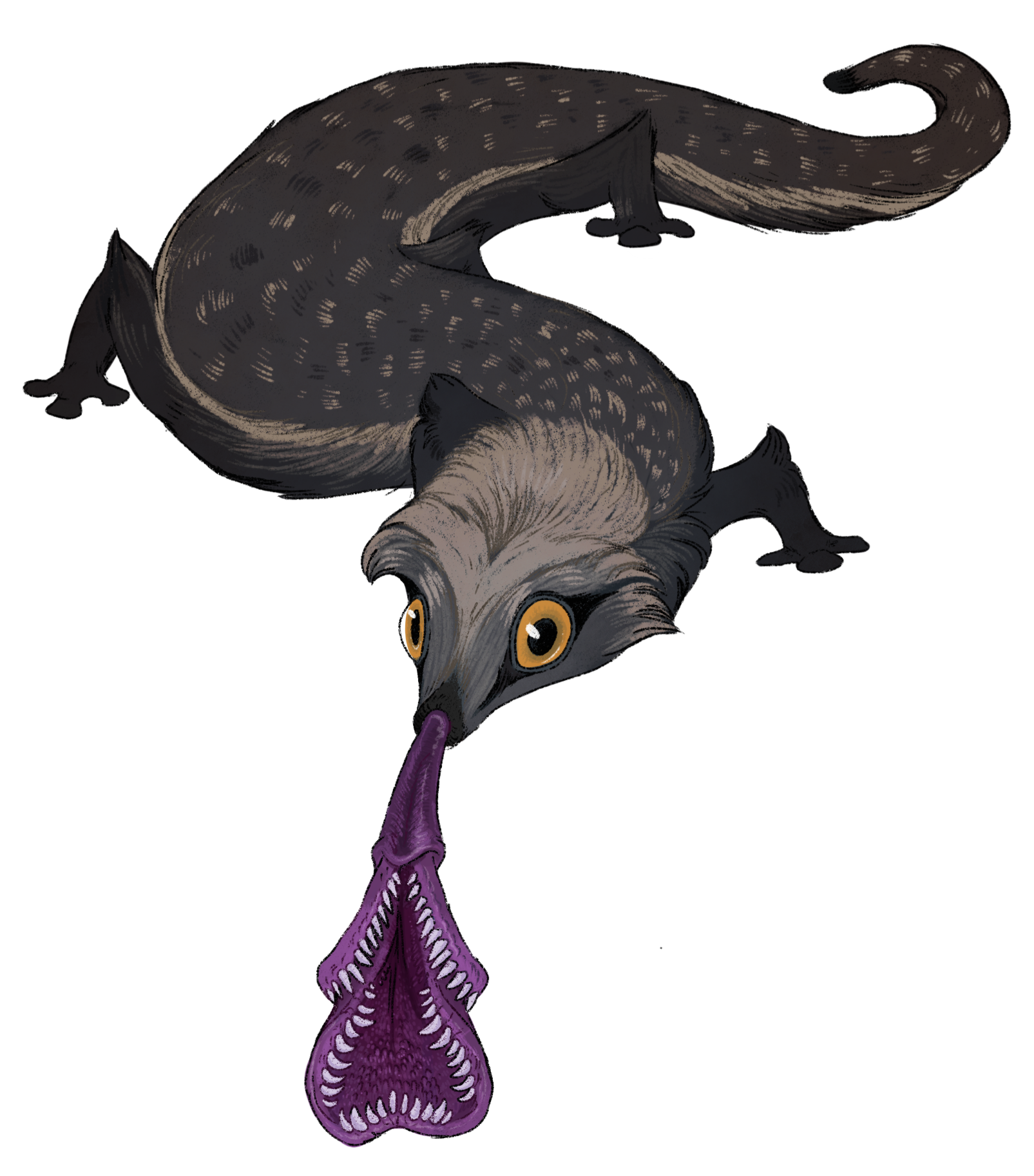
The eversible pharynx of the fantongue is more heavily toothed than even that of the grubhunter,
yet the fantongue is more of a scavenger than a hunter. It uses its frightening-looking mouth to scrape the
insides of pipes and any other tight crevice that might be harboring anything edible, from moss to the
creatures inhabiting it. As a consummate opportunist, fantongues also appear at carrion. Unable to
penetrate skin with their teeth, they wait for the body to be opened by other scavengers before moving
in to scrape at the carcass.
The fantongue also uses its pharynx to threaten predators, which has led to the organ being vibrantly colored
in many species.
Longbodied Wall-Lickers
(Muralambadae)
Longbodied wall-lickers have dedicated even more of their energy to scraping algae off walls, and have even found a novel way to climb them. They use both their suckerlike mouth and a flared anal pad to grip surfaces, and each end can create a seal strong enough to support their bodyweight, allowing them to inch their way up. Their limbs are small, but not useless, and they can scurry quite quickly along the ground if threatened.
Musclesuckers
(Myraptidae)
Musclesuckers are rather nasty members of the clade. They’re active predators who use their
shortened, muscular pharynxes to take sizable bites of larger creatures before fleeing. They’re particularly
hated as pests of livestock, since the injuries they cause can easily become infected. While they’re adapted
to this hit-and-run style of feeding, they won’t pass up more reasonably sized prey.
Musclesuckers are unique among this clade for the care they provide their offspring. Unlike other species
who simply leave their eggs in a place they hope will be safe, the musclesucker creates a den or burrow
(substrate allowing) where it makes its nest. Once the eggs hatch, the offspring are more or less independent,
but still remain near the burrow until they become so large their mother begins to view them as competition,
and chases them away.